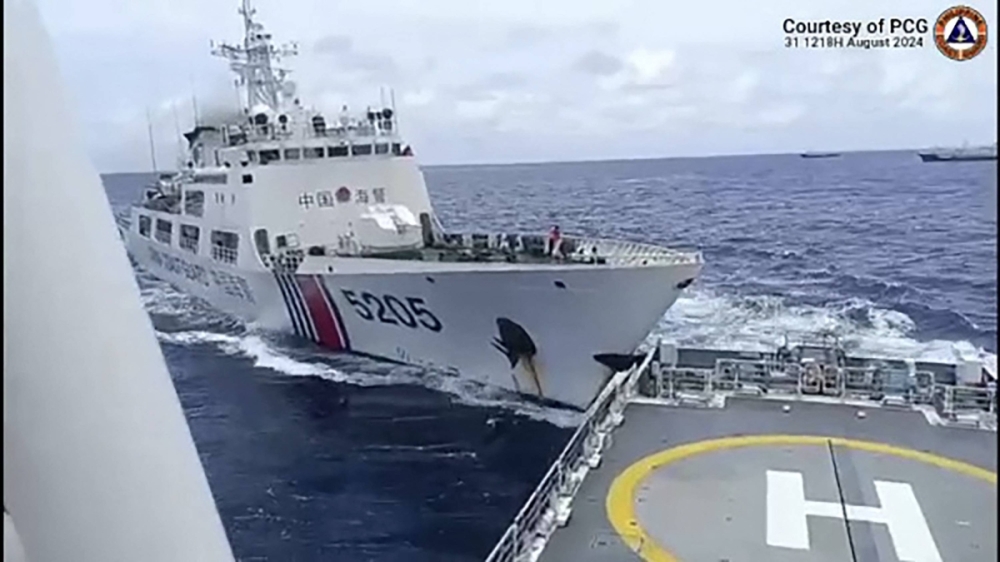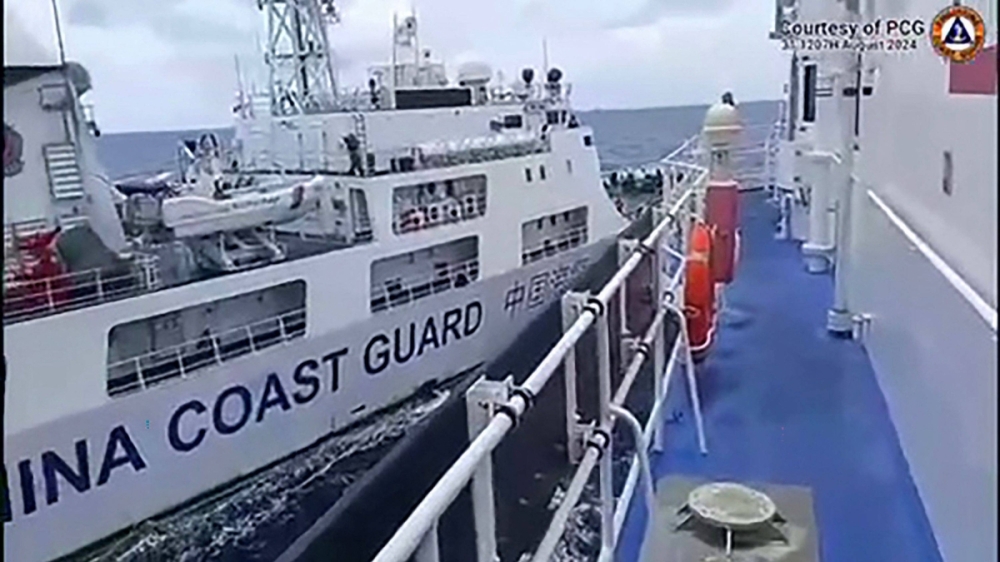WWIII
China comes under fire in latest South China Sea clash with Philippines

A screenshot taken from video footage shows a China Coast Guard ship colliding with the Philippine Coast Guard's BRP Teresa Magbanua near the Sabina Shoal in disputed waters of the South China Sea on Saturday. | Philippine Coast Guard / via AFP-JIJI
By Kathleen Benoza
STAFF WRITER
STAFF WRITER
JAPAN TIMES
Sep 1, 2024
Beijing has come under fire from Tokyo and Washington after a China Coast Guard vessel repeatedly struck a Japanese-made Philippine Coast Guard ship over the weekend in a flash point area of the disputed South China Sea.
The clash Saturday — the fifth such incident in August between China and the Philippines — occurred at the Sabina Shoal, located around 110 nautical miles (204 kilometers) from the Philippine coast, well within Manila’s exclusive economic zone. The shoal is claimed by both Beijing and Manila despite Hainan Island — the nearest Chinese landmass — being around 1,200 km away.
The Philippines has kept the 97-meter BRP Teresa Magbanua patrol vessel in the area since April 15. The construction of the ship, a Japan-made 97-meter vessel, was partially funded by an official development assistance loan by the Japan International Cooperation Agency.
The Philippine ship was “directly and intentionally” struck three times by a China Coast Guard vessel, resulting in what appeared to be significant damage, images posted by Philippine Coast Guard spokesman Jay Tarriela to his X account showed.
Tarriela stated that the Magbanua was initially surrounded in close proximity by multiple Chinese vessels, including maritime militia, and that the China Coast Guard ship had appeared to target the Magbanua in an “unprovoked” ramming while the Philippine vessel was on the move around the shoal.
The China Coast Guard said in a statement Saturday that the Magbanua had been “illegally lingering” at the Sabina Shoal — known by Beijing as Xianbin Reef and as Escoda Shoal by Manila — and added that the Philippine vessel had “weighed anchor and continued maneuvering provocatively within the lagoon of the reef.”
The statement claimed that the Chinese vessel had “lawfully issued verbal warnings and conducted monitoring and control measures” and that the Philippine vessel intentionally collided with the China Coast Guard ship.
“The responsibility lies entirely with the Philippine side,” China Coast Guard spokesperson Liu Dejun said. “We again sternly warn the Philippines to face reality and abandon illusions; the only correct course of action is for them to withdraw immediately.”
Philippine spokesman Tarriela stated that Manila has no intention of removing its vessel from the area "despite the harassment, the bullying activities and escalatory action of the Chinese coast guard."
Kazuya Endo, the Japanese ambassador to the Philippines, said in a post on his official X social media account that Tokyo — a “stakeholder” in the South China Sea — had expressed “serious concern” over the “repeated incidents” and that it “opposes any unilateral attempts to change the status quo by force or coercion.”

A screenshot taken from video footage shows a collision between one of its vessels and a China Coast Guard ship on Saturday, near the Sabina Shoal in disputed waters of the South China Sea. | Philippine Coast Guard / via AFP-JIJI
Beijing was quick to criticize Endo — who has been outspoken in his support for Manila in the South China Sea — with a spokesperson from China’s Embassy in the Philippines calling his criticisms “unprincipled” and riddled with “habitual bias.”
Chinese state-run media has lambasted Japan and the U.S. as “the real instigators behind the rising South China Sea tensions,” alleging that the two countries are attempting to “further escalate” the dispute “so that they can drag all regional countries into a united front against China.”
Beijing asserts control over nearly the entire South China Sea, despite overlapping claims from the Philippines, Brunei, Malaysia, Taiwan and Vietnam. The strategic waterway, through which $3 trillion in trade flows annually, is also thought to be abundant in oil, natural gas, and fish.
China has deployed what the Philippines says is an "excessive force" of 40 naval and coast guard vessels to the area of Sabina Shoal. This buildup aims, in part, to block the Philippines from resupplying the Magbanua. The move has heightened suspicions on both sides that the other may attempt to seize control of and build on the atoll.
China’s move to block access has not only halted Manila’s sea resupply missions but also resulted in severe damage to several vessels from collisions and water cannon attacks.
In a statement Saturday expressing its support for the Philippines, the U.S. condemned the “dangerous and escalatory actions” by Beijing “against lawful Philippine maritime operations” near Sabina Shoal, adding that China’s growing assertiveness in enforcing its claims of territorial sovereignty “threaten the freedoms of navigation and overflight of all nations.”
Sep 1, 2024
Beijing has come under fire from Tokyo and Washington after a China Coast Guard vessel repeatedly struck a Japanese-made Philippine Coast Guard ship over the weekend in a flash point area of the disputed South China Sea.
The clash Saturday — the fifth such incident in August between China and the Philippines — occurred at the Sabina Shoal, located around 110 nautical miles (204 kilometers) from the Philippine coast, well within Manila’s exclusive economic zone. The shoal is claimed by both Beijing and Manila despite Hainan Island — the nearest Chinese landmass — being around 1,200 km away.
The Philippines has kept the 97-meter BRP Teresa Magbanua patrol vessel in the area since April 15. The construction of the ship, a Japan-made 97-meter vessel, was partially funded by an official development assistance loan by the Japan International Cooperation Agency.
The Philippine ship was “directly and intentionally” struck three times by a China Coast Guard vessel, resulting in what appeared to be significant damage, images posted by Philippine Coast Guard spokesman Jay Tarriela to his X account showed.
Tarriela stated that the Magbanua was initially surrounded in close proximity by multiple Chinese vessels, including maritime militia, and that the China Coast Guard ship had appeared to target the Magbanua in an “unprovoked” ramming while the Philippine vessel was on the move around the shoal.
The China Coast Guard said in a statement Saturday that the Magbanua had been “illegally lingering” at the Sabina Shoal — known by Beijing as Xianbin Reef and as Escoda Shoal by Manila — and added that the Philippine vessel had “weighed anchor and continued maneuvering provocatively within the lagoon of the reef.”
The statement claimed that the Chinese vessel had “lawfully issued verbal warnings and conducted monitoring and control measures” and that the Philippine vessel intentionally collided with the China Coast Guard ship.
“The responsibility lies entirely with the Philippine side,” China Coast Guard spokesperson Liu Dejun said. “We again sternly warn the Philippines to face reality and abandon illusions; the only correct course of action is for them to withdraw immediately.”
Philippine spokesman Tarriela stated that Manila has no intention of removing its vessel from the area "despite the harassment, the bullying activities and escalatory action of the Chinese coast guard."
Kazuya Endo, the Japanese ambassador to the Philippines, said in a post on his official X social media account that Tokyo — a “stakeholder” in the South China Sea — had expressed “serious concern” over the “repeated incidents” and that it “opposes any unilateral attempts to change the status quo by force or coercion.”

A screenshot taken from video footage shows a collision between one of its vessels and a China Coast Guard ship on Saturday, near the Sabina Shoal in disputed waters of the South China Sea. | Philippine Coast Guard / via AFP-JIJI
Beijing was quick to criticize Endo — who has been outspoken in his support for Manila in the South China Sea — with a spokesperson from China’s Embassy in the Philippines calling his criticisms “unprincipled” and riddled with “habitual bias.”
Chinese state-run media has lambasted Japan and the U.S. as “the real instigators behind the rising South China Sea tensions,” alleging that the two countries are attempting to “further escalate” the dispute “so that they can drag all regional countries into a united front against China.”
Beijing asserts control over nearly the entire South China Sea, despite overlapping claims from the Philippines, Brunei, Malaysia, Taiwan and Vietnam. The strategic waterway, through which $3 trillion in trade flows annually, is also thought to be abundant in oil, natural gas, and fish.
China has deployed what the Philippines says is an "excessive force" of 40 naval and coast guard vessels to the area of Sabina Shoal. This buildup aims, in part, to block the Philippines from resupplying the Magbanua. The move has heightened suspicions on both sides that the other may attempt to seize control of and build on the atoll.
China’s move to block access has not only halted Manila’s sea resupply missions but also resulted in severe damage to several vessels from collisions and water cannon attacks.
In a statement Saturday expressing its support for the Philippines, the U.S. condemned the “dangerous and escalatory actions” by Beijing “against lawful Philippine maritime operations” near Sabina Shoal, adding that China’s growing assertiveness in enforcing its claims of territorial sovereignty “threaten the freedoms of navigation and overflight of all nations.”
No comments:
Post a Comment